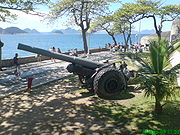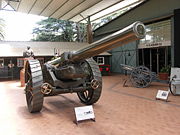
BL 6 inch Gun Mk 19
Encyclopedia
The BL 6 inch Gun Mk XIX was introduced in 1916 as a lighter and longer-range field gun
replacement for the obsolescent BL 6 inch Gun Mk VII
.
The gun barrel was of wire-wound construction: "The gun body is of steel and consists of tubes, a series of layers of steel wire, jacket, breech bush and breech ring".
"The breech mechanism is operated by means of a lever on the right side of the breech. On pulling the lever to the rear the breech screw is automatically unlocked and swung into the loading position. After loading, one thrust of the lever inserts the breech screw and turns it into the locked position. The breech mechanism is similar to that used on the 8 inch howitzers both in design and operation".
and the gun served in all theatres, with 108 being in service on the Western front at the end of World War I, but it did not completely replace the Mk VII gun until the end of the war.
3 batteries served with the BEF
in France early in World War II
, and others were deployed in the home defence of Britain. The gun was superseded by the 155-mm Gun M1
, and the carriages used for 7.2 inches (183 mm) howitzers.
 Brazil purchased these guns from USA in 1940 for coastal defense.
Brazil purchased these guns from USA in 1940 for coastal defense.
there were plans to use these guns in the fortification of Durban, Cape Town and Saldanha Bay.
For a short period, two guns were deployed for the protection of Port Elizabeth harbour at the outbreak of World War II
.


Field gun
A field gun is an artillery piece. Originally the term referred to smaller guns that could accompany a field army on the march and when in combat could be moved about the battlefield in response to changing circumstances, as to opposed guns installed in a fort, or to siege cannon or mortars which...
replacement for the obsolescent BL 6 inch Gun Mk VII
BL 6 inch Mk VII naval gun
The BL 6 inch Gun Mark VII was a British naval gun dating from 1899, which was mounted on a heavy traveling carriage in 1915 for British Army service to become one of the main heavy field guns in the First World War, and also served as one of the main coast defence guns throughout the British...
.
History, description
The gun was designed and built by Vickers specifically as a field gun, unlike its predecessors which originated as naval guns. Its length was reduced from the 45 calibres of its naval gun predecessors, to 35 calibres, to reduce weight and improve mobility. It utilized the modern carriage and recoil mechanism of the BL 8 inch Howitzer Mk 6.The gun barrel was of wire-wound construction: "The gun body is of steel and consists of tubes, a series of layers of steel wire, jacket, breech bush and breech ring".
"The breech mechanism is operated by means of a lever on the right side of the breech. On pulling the lever to the rear the breech screw is automatically unlocked and swung into the loading position. After loading, one thrust of the lever inserts the breech screw and turns it into the locked position. The breech mechanism is similar to that used on the 8 inch howitzers both in design and operation".
British service
310 were built during World War IWorld War I
World War I , which was predominantly called the World War or the Great War from its occurrence until 1939, and the First World War or World War I thereafter, was a major war centred in Europe that began on 28 July 1914 and lasted until 11 November 1918...
and the gun served in all theatres, with 108 being in service on the Western front at the end of World War I, but it did not completely replace the Mk VII gun until the end of the war.
3 batteries served with the BEF
British Expeditionary Force (World War II)
The British Expeditionary Force was the British force in Europe from 1939–1940 during the Second World War. Commanded by General Lord Gort, the BEF constituted one-tenth of the defending Allied force....
in France early in World War II
World War II
World War II, or the Second World War , was a global conflict lasting from 1939 to 1945, involving most of the world's nations—including all of the great powers—eventually forming two opposing military alliances: the Allies and the Axis...
, and others were deployed in the home defence of Britain. The gun was superseded by the 155-mm Gun M1
155 mm Long Tom
The 155 mm Gun M1 and M2 , widely known as Long Tom, were 155 millimeter calibre field guns used by the United States armed forces during World War II and Korean War. The Long Tom replaced the Canon de 155 mm GPF in United States service.-Development:Before entering World War I, the United...
, and the carriages used for 7.2 inches (183 mm) howitzers.
US Service
"Handbook of artillery" of May 1920 stated that :
"The original British ammunition so closely resembled the American that it was decided to use the [US] regular Mark II high-explosive shell... the propellant charge will consist of a base section and increment section having a total weight of approximately 25 pounds".
Brazil service

South African service
Prior to the outbreak of World War IIWorld War II
World War II, or the Second World War , was a global conflict lasting from 1939 to 1945, involving most of the world's nations—including all of the great powers—eventually forming two opposing military alliances: the Allies and the Axis...
there were plans to use these guns in the fortification of Durban, Cape Town and Saldanha Bay.
For a short period, two guns were deployed for the protection of Port Elizabeth harbour at the outbreak of World War II
World War II
World War II, or the Second World War , was a global conflict lasting from 1939 to 1945, involving most of the world's nations—including all of the great powers—eventually forming two opposing military alliances: the Allies and the Axis...
.
Surviving examples


- A gun bought by Brazil from USA in 1940 is displayed at the Brazilian Army museum, Copacabana.
- A Mark XIX mounted on a Mark XIII carriage can be seen at the South African National Museum of Military HistorySouth African National Museum of Military HistoryThe South African National War Museum in Johannesburg was officially opened by Prime Minister Jan Smuts on 29 August 1947 to preserve the history of South Africa's involvement in the Second World War. In 1975 the museum was renamed the South African National Museum of Military History and its...
, JohannesburgJohannesburgJohannesburg also known as Jozi, Jo'burg or Egoli, is the largest city in South Africa, by population. Johannesburg is the provincial capital of Gauteng, the wealthiest province in South Africa, having the largest economy of any metropolitan region in Sub-Saharan Africa...
. - The Apostle Battery in Hout BayHout BayHout Bay is the name of a coastal suburb of Cape Town, South Africa with a mix of neighbourhoods from the very rich to the very poor. It lies in a valley on the Atlantic Seaboard of the Cape Peninsula and is twenty kilometres south of the Central Business District of Cape Town...
, South AfricaSouth AfricaThe Republic of South Africa is a country in southern Africa. Located at the southern tip of Africa, it is divided into nine provinces, with of coastline on the Atlantic and Indian oceans...
has another on display. - A gun on display at Signal Hill, Cape TownSignal Hill (Cape Town)Signal Hill aka Lion's Rump, is a landmark flat-topped hill located in Cape Town, next to Lion's Head and Table Mountain.The hill is also known as "The Lion's Flank", but this term is obsolete...
, South Africa.
See also
- Canon de 155mm GPFCanon de 155mm GPFThe Canon de 155 Grande Puissance Filloux mle.1917 was a 155 mm cannon used by the French Army during the first half of the 20th century.-History:The gun was designed during World War I by Colonel L.J.F...
French equivalent - 15 cm Kanone 1615 cm Kanone 16The 15 cm Kanone 16 was a heavy field gun used by Germany in World War I and World War II. Guns turned over to Belgium as reparations after World War I were taken into Wehrmacht service after the conquest of the Belgium as the 15 cm K 429...
German equivalent - List of field guns

